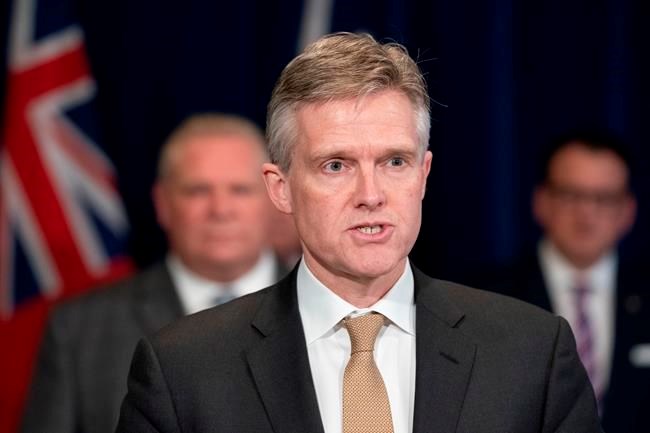TORONTO — Ontario introduced a $17-billion package Wednesday to support the province through the COVID-19 outbreak, including an influx of cash for the health sector, direct payments to parents, and tax breaks for businesses.
Finance Minister Rod Phillips said the government is confident that every dollar invested through the plan that saves a life or a job is a dollar well spent.
"COVID-19 is an extraordinary threat to the health and economy of Ontario — the greatest we've faced in my lifetime — and it demands an extraordinary response from all levels of government and civil society because we're all in this together," he said while tabling an emergency one-year fiscal outlook.
All parties worked together to get the legislation passed in one afternoon.
The spending boost includes a $1-billion COVID-19 contingency fund, nearly $1 billion more for hospitals, and more personal protective equipment for front-line workers.
Measures also include a one-time payment for parents of $200 per child 12 years old and under, doubling payments for low-income seniors and suspending student loan payments for six months.
The plan includes both $7 billion in new spending and $10 billion in tax and other deferrals. The moves will contribute to a major hit to Ontario's bottom line, pushing the deficit from $9 billion to a projected $20.5 billion for 2020-21 — a level not seen since the aftermath of the 2008 recession.
More than $3 billion in funding is directed toward health care. In addition to the COVID-19 fund and the hospital spending boost — which includes money for 1,000 acute care and 500 critical care beds — the plan includes $243 million for surge capacity in the long-term care sector, $160 million for public health and $75 million for more personal protective equipment and medical supplies.
"There are certain moments that define a generation. COVID-19 is one of those moments," Phillips said while tabling an emergency one-year fiscal outlook Wednesday.
"The closed schools and quiet streets will be remembered. But eventually, their memory will become more distant. But I will never forget...hearing cheers from nearby porches and balconies along the street for the front-line health-care workers at Ajax-Pickering hospital. Long after we defeat COVID-19, the Ontario spirit, at home in Ajax and across Ontario, will remain."
Parents will be able to get the $200 payments to help offset costs of school and daycare closures at a cost of $337 million to the province. Guaranteed Annual Income System payments for low-income seniors will be doubled for six months. Eligibility will be expanded for the Low-income Energy Assistance Program, with an additional $9 million going to breaks on energy bills.
People with student loans will get a six-month break on making Ontario Student Assistance Program loan repayments, and not accrue extra interest. Indigenous communities will see an additional $26 million for health care and critical supplies.
The province will temporarily increase the Employer Health Tax exemption for 57,000 employers at a cost of $355 million.
As well, businesses will get five months of interest and penalty relief to file and make payments for provincially administered taxes, at an estimated cost of $6 billion, employers will be allowed to defer Workplace Safety and Insurance Board payments, at a cost of $1.9 billion, and about $1.8 billion will be used to defer municipal remittance of education property tax to school boards, allowing municipalities to provide property tax deferrals to residents and businesses.
NDP Leader Andrea Horwath said she had hoped the fiscal update would go further, and provide more financial aide to people who are struggling.
"People have seen their incomes drastically cut or eliminated all together," she said. "That didn't just start today. That's been ongoing for almost two weeks...People need help. People need help now."
Phillips had originally been planning to introduce a full budget Wednesday, but instead tabled a one-year fiscal outlook in light of the global pandemic's uncertain future impacts on the economy. A full budget will be tabled by Nov. 15.
It came as the province reported 100 new COVID-19 cases Wednesday, bringing the provincial total to 688. It included a ninth death and at least five people who are hospitalized, including a woman in her 20s.
The economic plan contains unusually high levels of reserves and contingencies in order to weather future shocks, including the $1-billion COVID-19 contingency fund, a $1.3-billion general contingency fund and what Phillips calls an "unprecedented" $2.5-billion reserve.
Ontario is projecting zero per cent real GDP growth in 2020, a net-debt-to-GDP ratio of 41.7 per cent in 2020-21 — up from 39.9 per cent — and a ballooning net debt from $355 billion to nearly $380 billion.
This report by The Canadian Press was first published March 25, 2020.
Allison Jones, The Canadian Press

